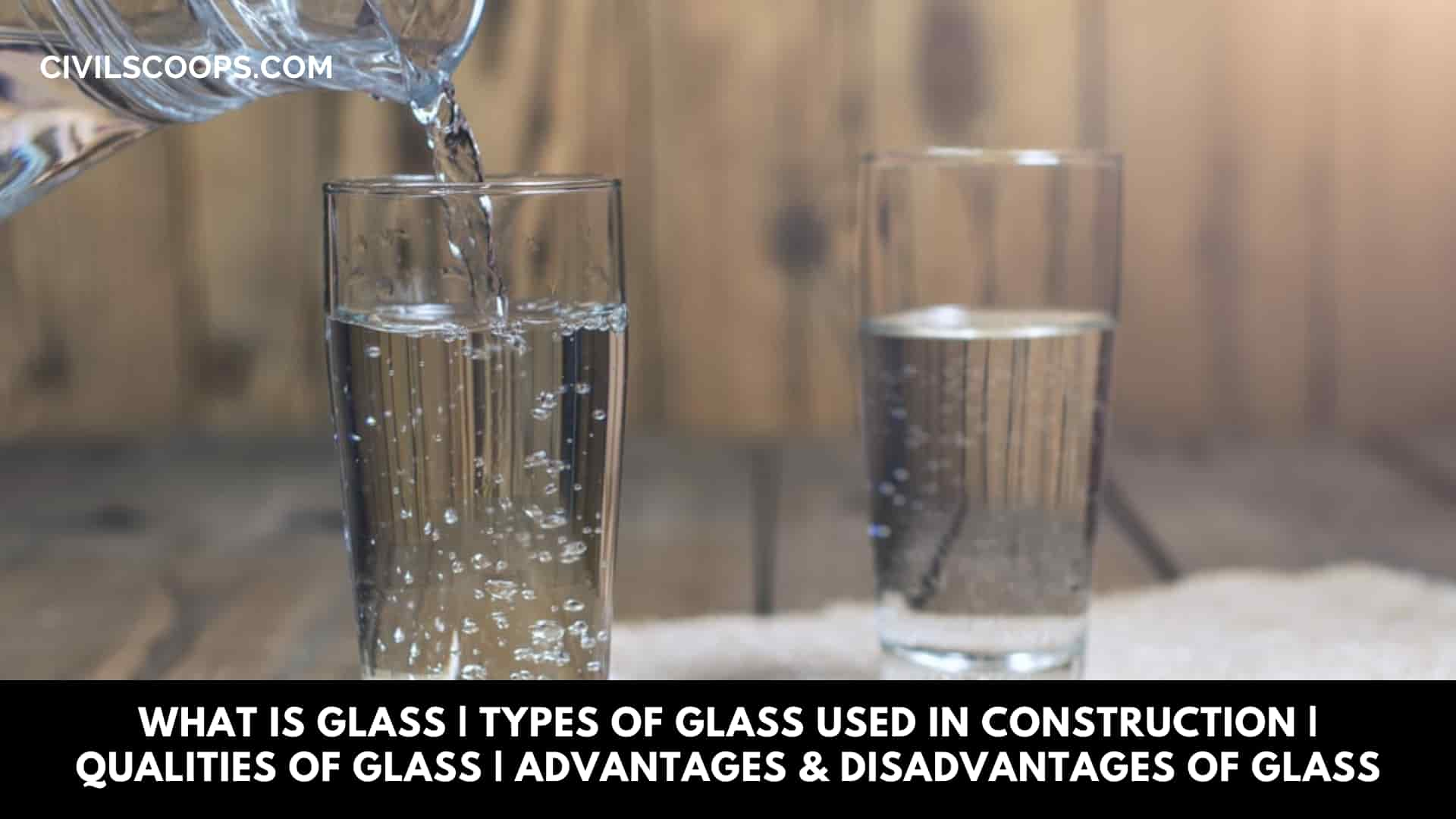
Table of Contents
What Is Glass?
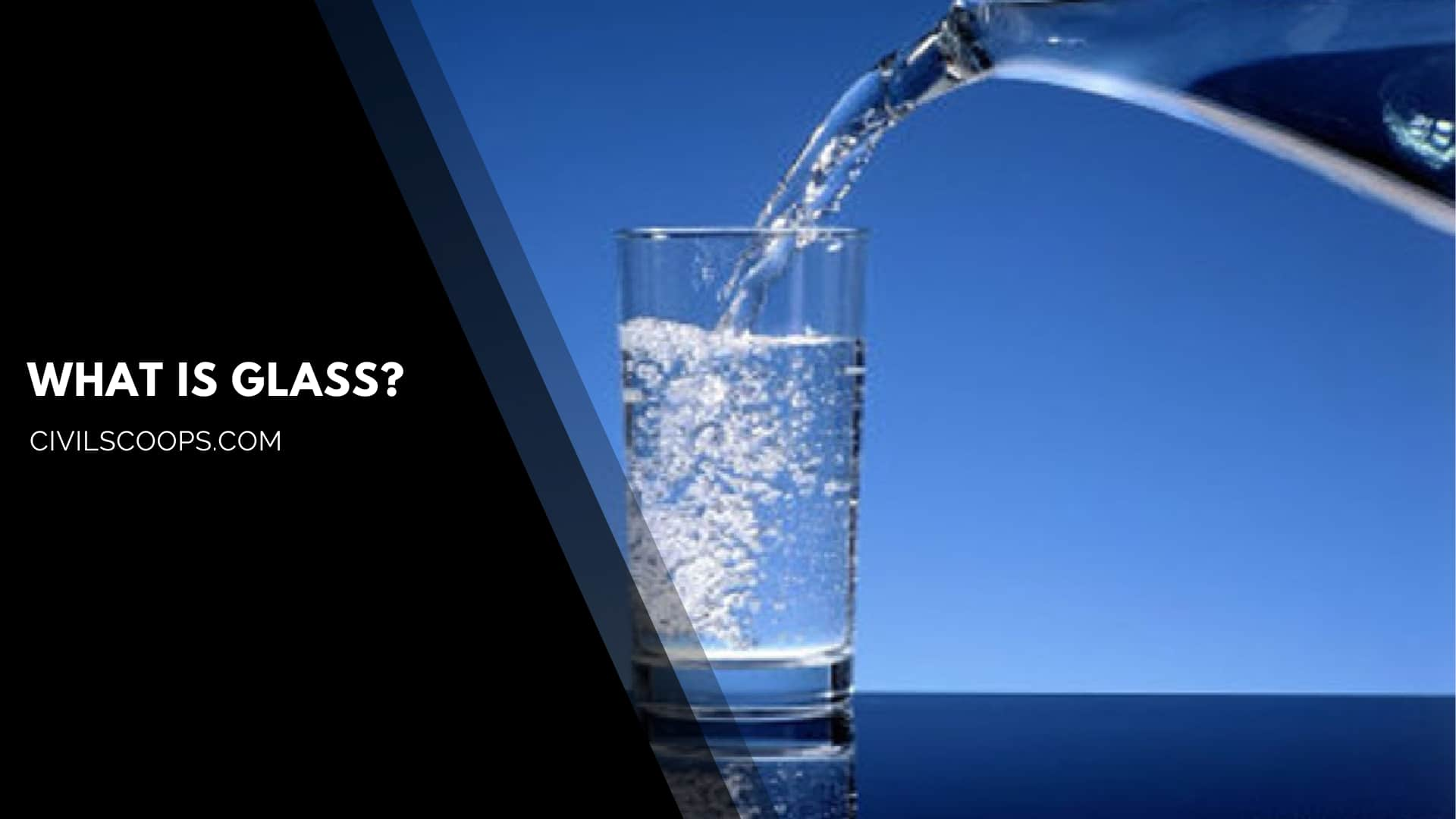
Glass is generally the oldest material and fancy material which is used in the building industry and for other purposes. Glass is generally installed to enhance the beauty of the structure and provides a premium look.
Glass is also a fascinating material among people since its discovery. Glass is basically a hard material that is transparent in nature. Glass is formed by providing heat to quartz or sand; glass is also an inorganic material.
Glass is a glazing material that is the first choice for architects for new and unique design & beautiful outlook. Glass is the most versatile material which is used in the construction industry.
Types of Glass Used in Construction
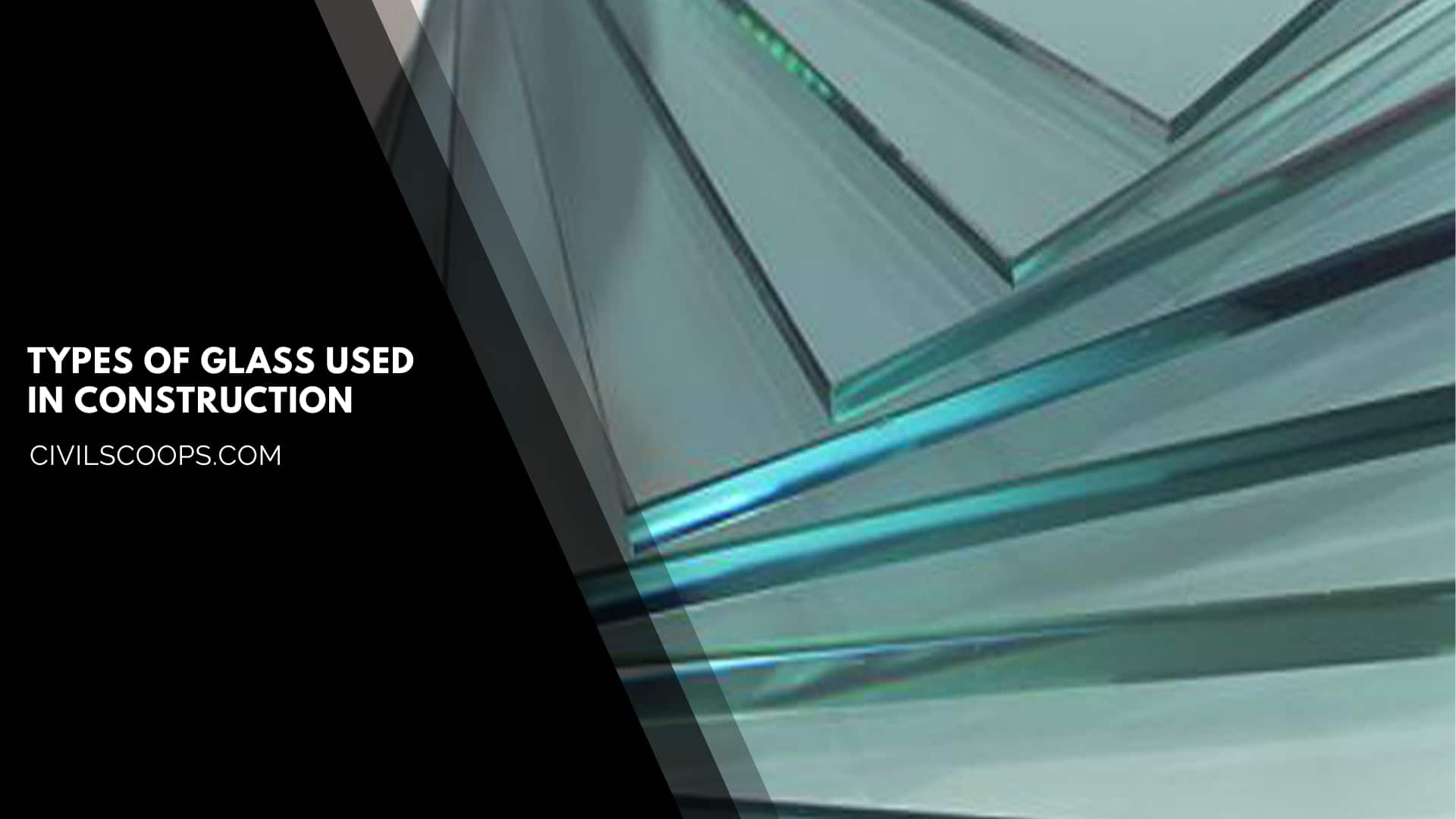
There are 11 types of glass that are available in the marketplace and used in the construction industry, Those properties are as follows.
- Float Glass.
- Sheet or Flat Glass.
- Shatterproof Glass.
- Laminated Glass.
- Energy-efficient Glass.
- Wired Glass.
- Chromatic Glass.
- Tinted Glass.
- Toughened Glass.
- Extra-clean / Self-cleaning Glass.
- Glass Blocks.
1. Float Glass:
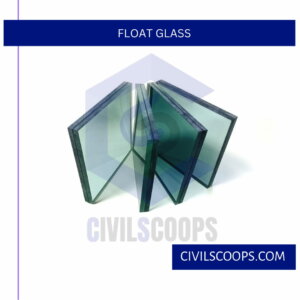
Float glass is also a very popular glass type that is widely used for construction purposes. Float glass is made of sodium silicate and calcium silicate.
This type of glass is also known as soda-lime glass. The float glass is termed float because of the manufacturing process as molten glass will float on the molten tin bed.
This process provides us with smooth, clean, flat, distortion-free glass. Float glass does not need to be cut with any kind of special cutters. This type of glass is available in different thicknesses, which are 2 mm to 20 mm.
The weight of float glass is nearly 6 kg to 36 kg. This type of glass is installed in the window openings, in front of shops, and also in public places.
2. Sheet or Flat Glass:
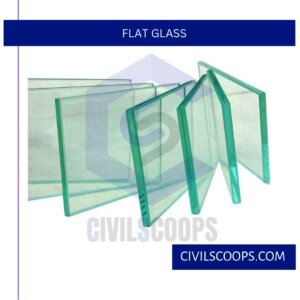
Sheet glass is a type of glass that is widely used for construction purposes. Sheet glass is produced in a special method; at the first molten glass is passed through the rollers to receive a flat and neat surface finish glass.
No special type of equipment is required to cut the flat glass; it needs only a glass cutter to cut the flat glass. Sheet glass is available in the marketplace in different price ranges and different sizes and thicknesses.
The cost of this glass is comparatively lower than other types of glass, and distortion is also less in this type of glass; for this reason, flat glass is used in the glazing greenhouses. Flat glass is also used in domestic windows, doors, etc.
Also Read: All About of Window | What Is Window | Selection Criteria for a Window | Types of Windows
3. Shatterproof Glass:
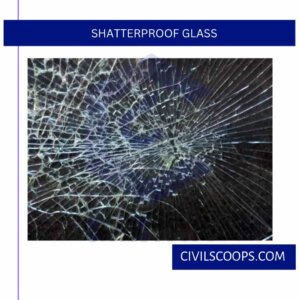
Shatterproof Glass is a modern type of glass that is used in different places now. Shatterproof Glass is used to resist the shattering shock. This type of glass does not break into pieces.
In the time of preparation of Shatterproof Glass, we add some other thing termed as plastic polyvinyl butyral resin, which prevents the glass from forming any kind of sharp pieces.
The cost of shatterproof glass is a little bit higher than the other type of glass. Shatterproof Glass is generally used in floors, windows, skylights, etc.
4. Laminated Glass:
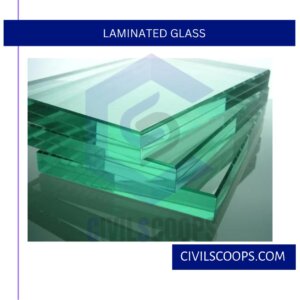
Laminated glass is trendy nowadays, and this glass is prepared by ordinary glass layers, which are ordinary and flexible materials. Laminated glass is made with three or layers of ordinary glass layers.
Laminated glass can resist UV rays which are very harmful to people. Laminated glass can resist sound; so, it is used as a soundproof material.
This type of glass is used in bridges and aquariums because it has sound resistance properties. Laminated glass is the best material for build canopies because it can reduce harmful rays.
Laminated glass is prepared with two toughened glass which is laminated in the middle portion. The cost of this type of glass is moderate, and it is available in the market in 6 mm toughened/2.28 mm toughened/5 mm toughened.
5. Energy-Efficient Glass:
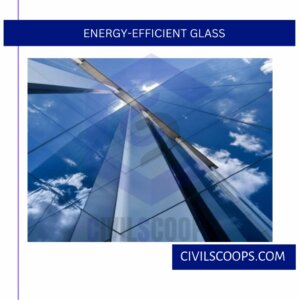
Energy-efficient glass is a special type of glass that is widely used nowadays. Energy-efficient glass is used as building material which is manufactured by glazing float glass which has a thin coating on one side of this type glass.
The price of this type of glass is very high. The energy-efficient glass allows passing the solar energy in one direction. Energy-efficient glass also allows the transfer of heat energy in one other direction.
This type of glass also requires highly skilled laborers, which is another reason for the price hiking of this glass.
6. Wired Glass:
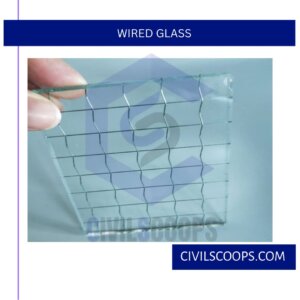
Wired glass is a shining example of modern technology. Wired glass is a type of glass that is prepared with wire mesh. In the time of preparation of wired glass, a wired mesh is provided in the middle portion of the structural glass.
The main purpose of providing the wire mesh is to hold the whole glass together and resist it from breaking or cracking. Wired glass is available in a large span because the wired mesh protects that large span.
The wired mesh also protects the wired glass from breaking into small pieces. This type of glass is available in the market as clear or obscured. Wired glass is used in the industrial areas and the garage areas.
7. Chromatic Glass:
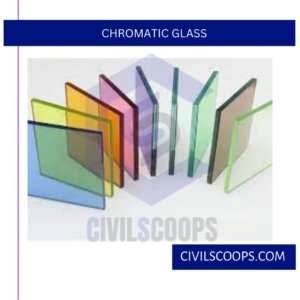
Chromatic glass is a special type of glass that is used in the ICUs and the meeting rooms. Chromatic glass has a special ability to protect the interior portion from daylight.
The price of this type of glass is higher than other types. Sometimes, chromatic glass maybe have electric lamination (electro-chromatic). Chromatic glass also has thermo-chromatic (as heat-sensitive lamination) and photochromic (has light-sensitive lamination).
8. Tinted Glass:
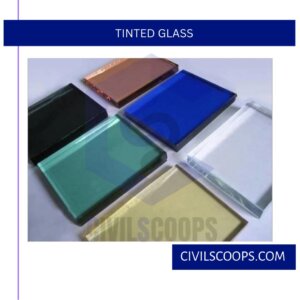
Tinted glass is a very well-known and popular glass, and it is widely used all over the world. Tinted glass is basically colored glass that is mainly used in buildings.
In the time of preparation, we add some special type of iron in the glass mix to get those different colors in the tinted glass. The main advantage of using this glass is it looks very attractive and colorful, and the color does not affect the property of the glass.
Tinted glass is used in the windows, roofs, etc. At the time of manufacture, we added iron oxide to get green color in the tinted glass and added sulfur to get blue color.
9. Toughened Glass:
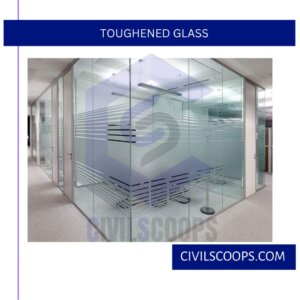
Toughened is a type of glass that is used in general industrial areas. Toughened glass is the most potent glass which is used in the construction industry.
This type of glass is used to resist breaking; that’s why It is termed tempered or safety glass. In the time of breaking, it does not break into smaller pieces like ‘safer,’ but it breaks into larger pieces like a float glass.
Toughened is generally used in interior places like the kitchen because it has good resistance properties. This type of glass is also used in the glass balustrade, swimming pool fencing, and shower screens. Sometimes, toughened glass is used in the laminated panel. The price of toughened glass is also higher than ordinary ones.
10. Extra-Clean / Self-Cleaning Glass:
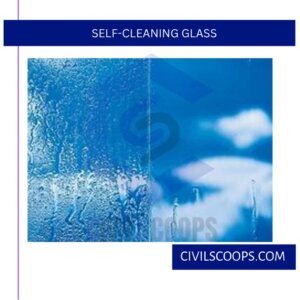
Extra-clean or Self-cleaning Glass is a new type of glass, which is not used frequently in the previous time. Extra-clean or Self-cleaning Glass has a hydrophobic and photocatalytic type of nature.
The hydrophobic and photocatalytic property makes the self-cleaning or extra clean glass a stain-proof material. Extra-clean or Self-cleaning Glass is very attractive to look at, and it is easy to maintain.
11. Glass Blocks:
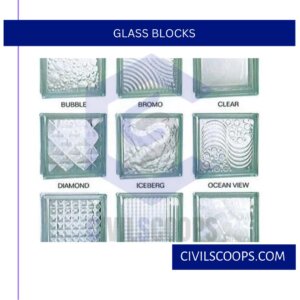
Glass block is a very well-known and popular material. Glass blocks are manufactured in two different types, one is solid, and another one is hollow.
Glass blocks are generally manufactured into two separate halves; when the glass is molten, then two halves are pressed together. Some vacuum portion is still there in the portion of joining.
Hollow glass wall blocks are generally allowed to access the sunlight into the inside portion of the building. Highly skilled laborers are needed to install the glass blocks, that’s why the price of this is also a little bit high.
Qualities of Glass
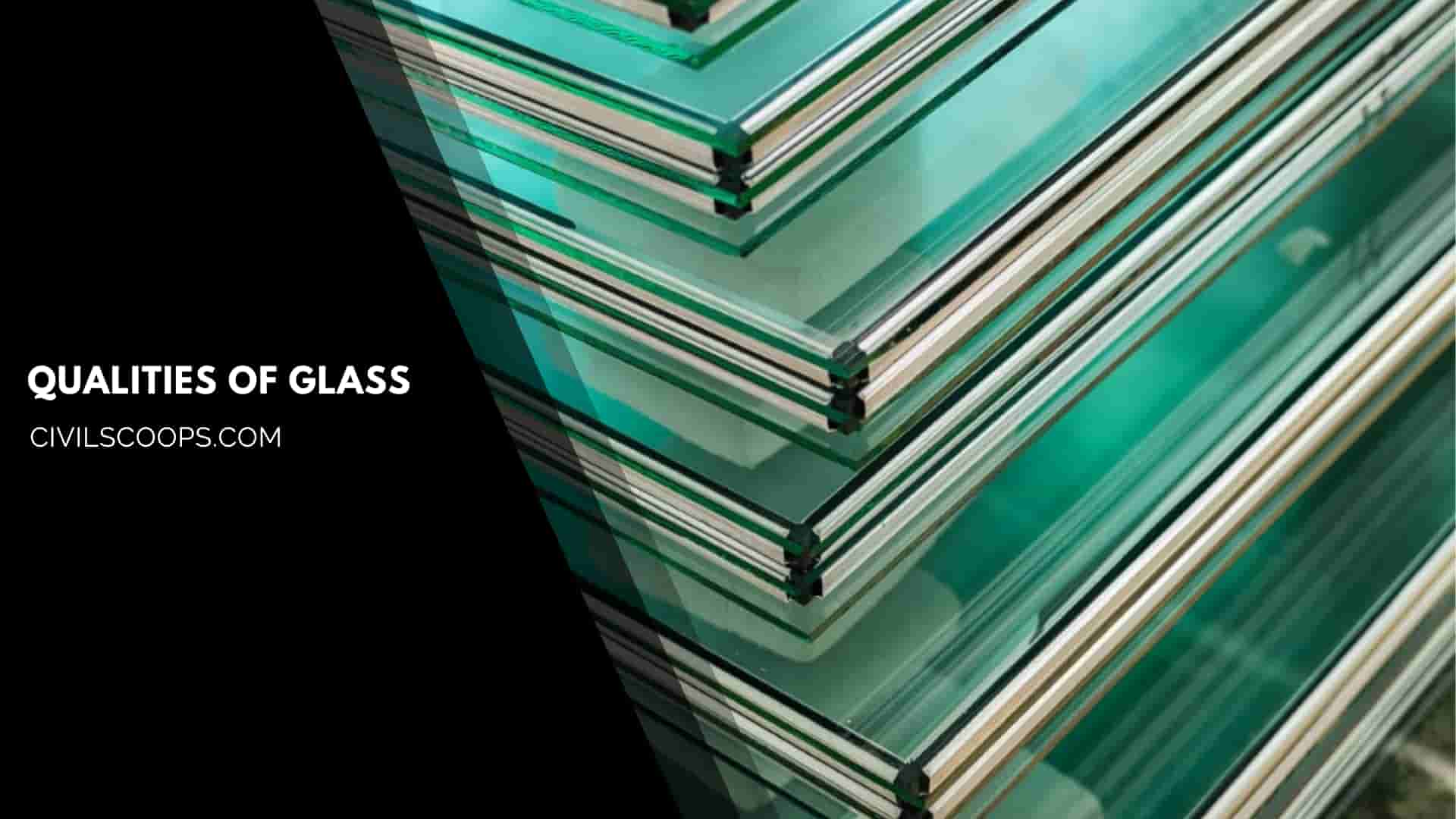
There are generally five engineering properties of glass, and those properties ensure the use of glass for construction purposes. Those properties are as follows.
- Transparency: The main property of using glass is transparency. Because of this, we can able to see from inside to outside. Transparency also allows us to see from outside to inside; so, it is a two-way process, and sometimes it also acts as a mirror; that time, you can only be able to see from one side.
- Workability and Recycle property: Glass has excellent workability, and it is molded into different shapes and sizes. Glass is also a 100% recyclable material, and it is used as a raw bacterial of construction.
- Strength: Glass is naturally a brittle material, but if we add some admixtures and laminates, then the strength of glass will increase. The strength of glass is measured by the modulus of rupture value.
- Transmittance: Transmittance is the property of glass by which a visible fraction of light passing through the glass.
- U value: U value is the property of the glass, which refers to how much heat is transferred through the glass. Generally, insulated glass particle shows lower U value because the insulation is not the conductor of heat.
Advantages of Glass
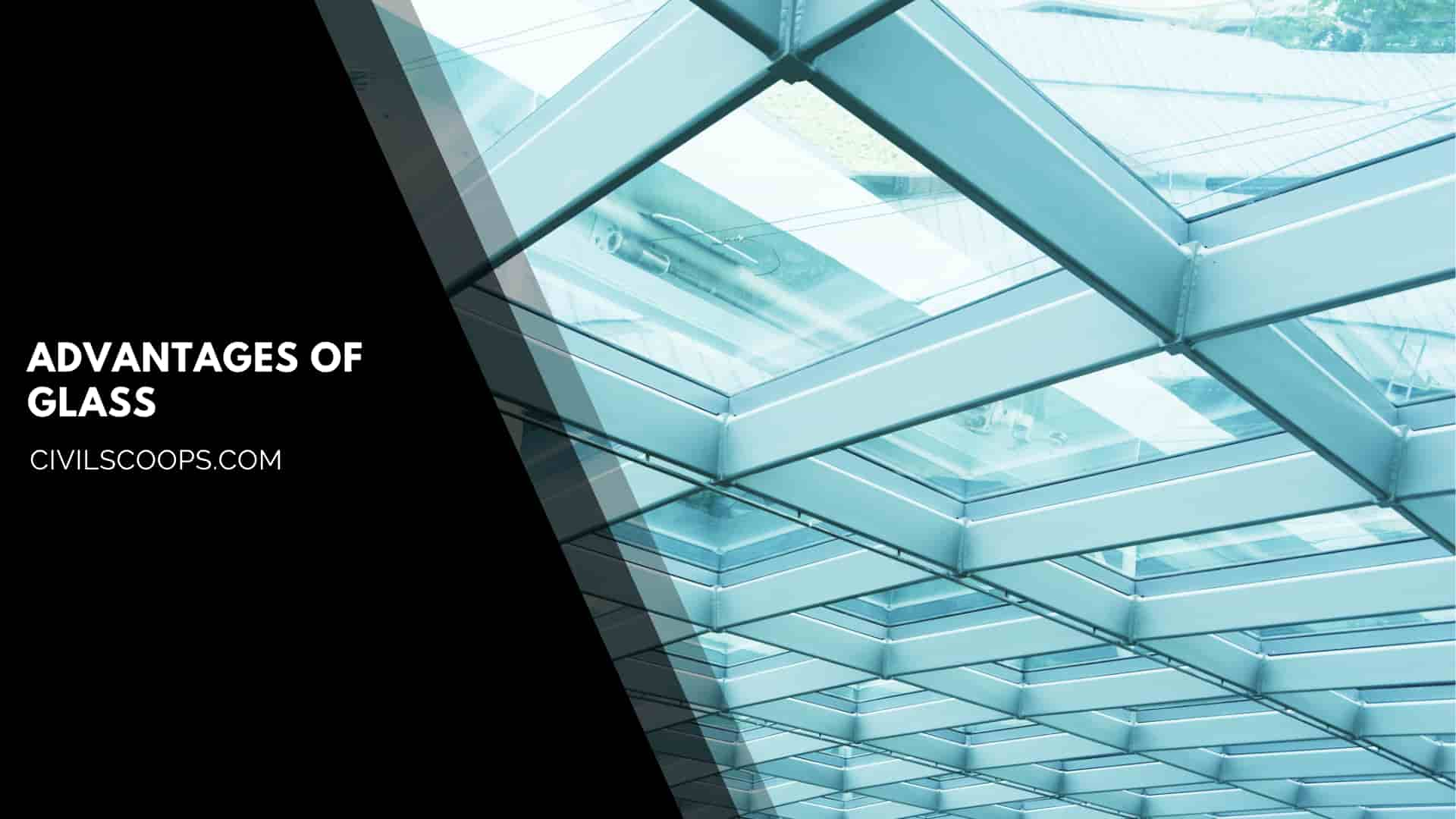
There are many advantages of using glass in construction, Those properties are as follows.
- Good Transparency: One of the best transparent materials is glass which allows passing the light, and the objects behind the glass are visible clearly. The main advantage of using glass is you can connect the outer world visually. If the door and windows are closed, then the glass allows to enter the light and saves the energy of electricity.
- Waterproof and Dustproof: The advantage of using glass is it’s waterproof. It saves all the things behind the glass from the water. Another advantage of using glass is it’s dustproof. Due to its smooth surface, it becomes dustproof and easy to clean, and easy to maintain.
- Availability of color: Glass is available in a wide range of colors in the market. If you combine the glass sheet in the insulated or laminated units, it changes the color and enhances the beautiful appearance. Generally, laminated glass is made with a wide variety of colors, and it shows different lighting effects.
- Recyclable: Another advantage of using glass is it is recyclable, so you can save energy. It is also a cost-effective process and also reduces water pollution and air pollution. Glass material is fully recyclable, and after the recyclable process, the quality and purity have remained the same as the previous one.
- UV stable: Glass can resist UV rays, and it is free from disintegration and discoloration. This is another advantage of glass.
- West and Rust Resistant: Glass is anti-corrosive material among all the building materials, and glass is rarely attacked by some chemicals. Glass is totally weather-resistant, and it helps to resist wind, sun, rain, etc.
- Easily Moulded: Glass is prepared by applying heat to the sand; it is a transparent material that is remolded into different shapes. The glass is prepared into different shapes for using different places like building windows, building doors, shop fronts, workshops, etc.
- Electricity insulation: Glass material is a good insulator and resists conducting electricity; so, it can protect you from all types of electrical damages. For this unique property, glass is used in wall light decoration, ceiling light formation, and other electrical applications.
Disadvantages of Glass
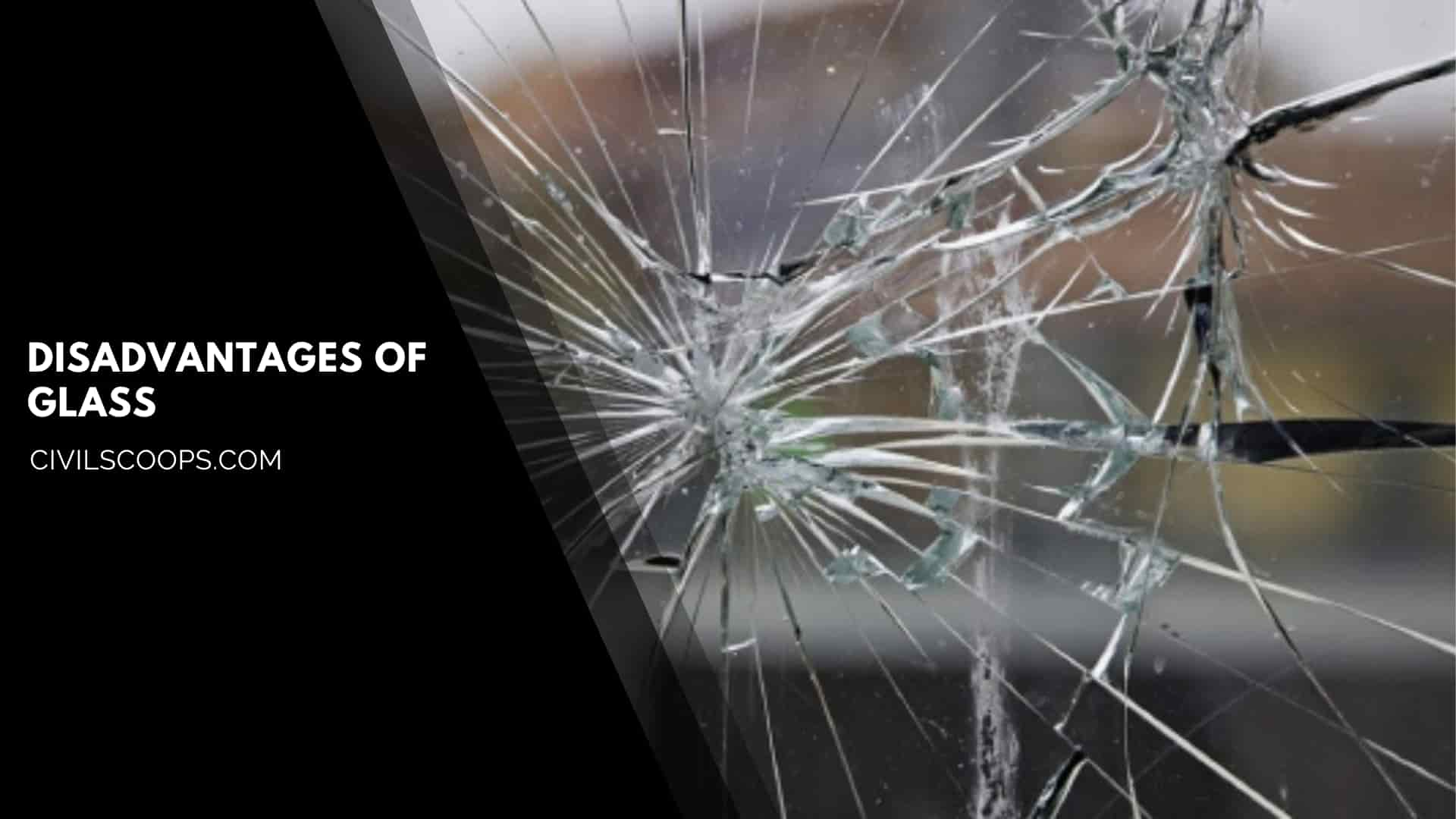
Like disadvantages, glass also has some disadvantages, Those properties are as follows.
- Higher Cost: The manufacture of glass is a very costly process because it requires a high temperature for processing. Using glass increases the total cost of the building, and it also reduces the privacy of the building because it is transparent in nature.
- Brittleness of Glass: Another disadvantage of glass is it’s very brittle in nature. Glass is rigid and stiff then applying loads of glass will break down without showing any significant strain. The broken glass piece is very harmful and dangerous.
- Low Impact Resistance: Glass is very weak in impact load; it suddenly collapse without showing any type of failure signs after applying impact loads.
- Corrosion Due To Alkali Solution: Glass is highly sensitive to alkaline ions. Alkali corrosion takes place in the glass.
- Unsafe for an earthquake: In earthquake-prone areas, the buildings are specially designed for lateral loads and movements, but glass can not take those types of movements. So, it will break down easily.
- High Maintenance Cost: In dust and humid areas, dust particle sticks with the glass and then it will be very difficult for maintenance.
What Is Glass Made Of?
Glass is made from natural and abundant raw materials (sand, soda ash and limestone) that are melted at very high temperature to form a new material: glass. At high temperature glass is structurally similar to liquids, however at ambient temperature it behaves like solids.
What Is Beveled Glass Mirror?
Beveled mirrors are types of mirrors that have edges cut at a certain angle, and are cut to the desired dimensions. Beveled mirrors serve the same purpose as any other mirror, a decorative item that reflects light. However, a beveled edge gives a mirror a more embellished look.
What Does Beveled Glass Look Like?
Beveled glass has angled edges that are cut and polished, creating a kaleidoscope-like or prismatic type of effect. This creates a colorful look that plain panes won’t have. A beveled piece of glass, window, or mirror adds a sense of style and visual interest.
What Is Float Glass Used For?
Float glass is essentially a super smooth, distortion-free glass which is used for designing other glass items such as laminated glass, heat-toughened glass, and so on.
How Flat Is Glass?
Glass isn’t naturally flat; it has to be carefully worked to make it flat. Much of the plate glass, that is, the flat glass used in windows etc, in the world is manufactured by the float technique developed by Pilkington in the 1950s. In this technique, molten glass floats in a bath of molten tin.
What Is Shatterproof Glass Called?
Laminated Glass (aka “Shatterproof Glass”)
When this type of laminated security glass does break, it holds glass shards in place to prevent the glass from shattering dangerously inwards.
What Is Laminated Glass Used For?
Laminated glass is used for architecture, glazing, automobile safety, photovoltaic, UV protection, and artistic expression. The most common use of laminated glass is skylight glazing and automobile windshields.
What Is Energy Efficient Glass?
Energy-efficient glazing is the term used to describe the double glazing or triple glazing used in modern windows in homes. Unlike the original single glazing or old double glazing, energy-efficent glazing incorporates low-emissivity coated glass to prevent heat escaping through the windows.
What Is the Most Energy Efficient Glass?
Fiberglass. Fiberglass is the most energy-efficient and durable window frame material but also the most expensive.
What Is Wired Glass?
variants or less commonly wired glass. : glass with wire netting embedded in it during manufacture to reduce the probability of its shattering when cracked by shock or by heat. called also safety glass.
Is Wired Glass Fire Rated?
Safety wired glass products are tested to and meet the highest safety requirements mandated by both the code and the federal government’s Consumer Products Safety Commission (CPSC), and have attained a fire rating after stringent fire testing.
How Is Glass Tinted?
Body tinted glass products are produced by small additions of metal oxides to the float or rolled glass composition. These small additions color the glass bronze, green, blue or grey but do not affect the basic properties of the glass except for changes in the solar energy transmittance.
How Is Glass Toughened?
Toughening. Toughened or tempered glass is a type of safety glass. Toughened glass is made by heating annealed (float) glass uniformly through a furnace to temperatures exceeding 600 C. The annealed (float) glass is then transferred to the quenching chamber of the furnace where it is rapidly cooled.
Is Tempered Glass Fire Resistant?
Standard tempered glass products have a fairly high heat rating; these materials generally shatter around 500 °F. But this is not high enough to ensure optimal safety. Fire-rated glass, on the other hand, is specially manufactured to be able to withstand high heat.
What Is Stained Glass Made Of?
Stained-glass windows, made up of coloured and painted glass pieces held together by lead strips, were especially popular in Europe in the period between 1150 and 1550, when they were a prominent feature of cathedrals and other churches, as well as city halls and homes for the elite.
Like this post? Share it with your friends!
Suggested Read –
- What Is Stone | Types of Stone | Uses of Stones
- How Cement is Made | Cement Ingredients | History of Cement
- All About of Corrosion | What Is Corrosion | 9 Different Types of Corrosion
- What Is Hard Hat | Hard Hat Colour Definition | Different Hard Hat Colour Codes | Types of Safety Helmets | Classification of Hard Hats
- What Is Pier and Beam Foundation | Advantages & Disadvantages of Pier and Beam Foundations | Pier and Beam Foundation Design | How to Build a Post and Pier Foundation